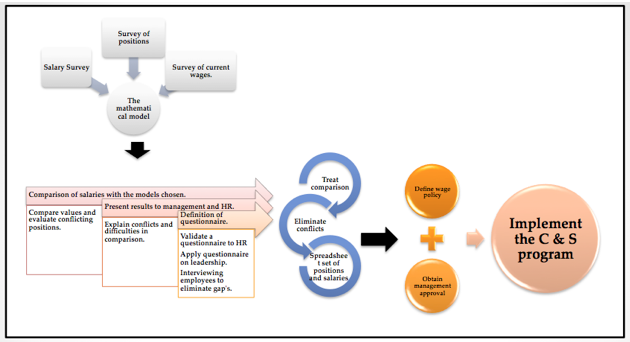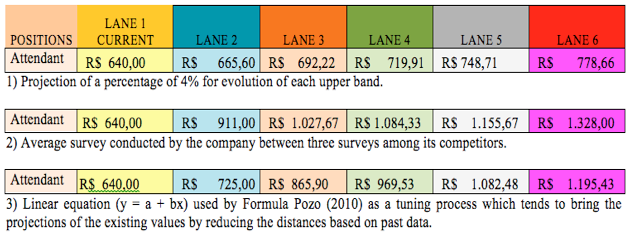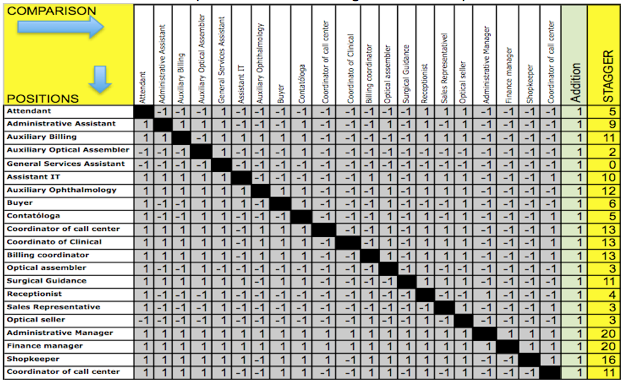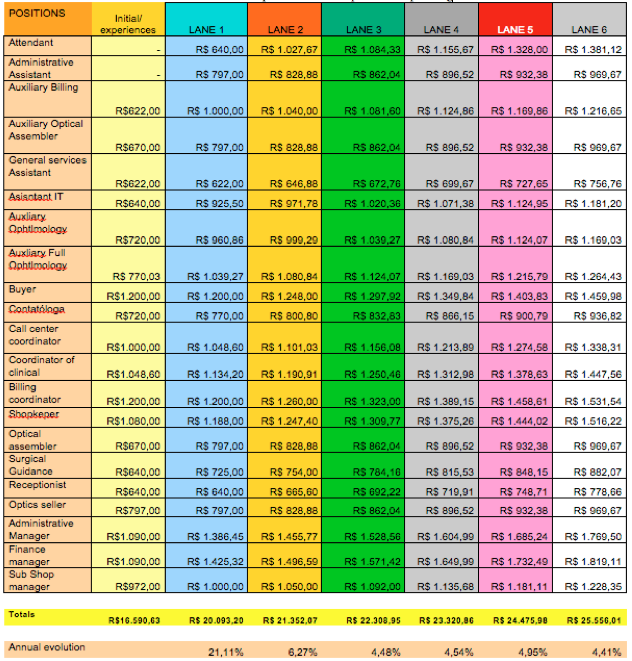

 HOME | ÍNDICE POR TÍTULO | NORMAS PUBLICACIÓN
HOME | ÍNDICE POR TÍTULO | NORMAS PUBLICACIÓN Espacios. Vol. 37 (Nº 10) Año 2016. Pág. 7
Jadir P. dos SANTOS 1; Flavio Galio Araujo DUTRA 2; Iris Bento da SILVA 3; Márcia Donizete Leite OLIVEIRA 4
Recibido: 02/12/15 • Aprobado: 22/01/2016
ABSTRACT: By means of a qualitative research analysis with documentary base on secondary sources and of descriptive and exploratory field, was evaluated the applicability of the use of regression analysis to the implementation of a policy positions and salaries using the grouping of binary comparison and regression analysis, in a small family business of providing services with 56 employees in a non-participant observation. Were evaluated three mathematical methods for calculating salary and the scaling method, through the binary comparison, the key positions that are compared in pairs, so that each position in question is compared to another, resulting in a hierarchy. The study revealed that there really is the possibility of implementing a policy positions and salaries, provided that the direction of small business, run by family, uses a hybrid system keeping the defined policy. |
RESUMO: Por meio de uma análise de pesquisa qualitativa com base documental em fontes secundárias e de campo descritivo e exploratório, foi avaliada a aplicabilidade do uso da análise de regressão para a implementação de uma política de cargos e salários, usando o agrupamento do binário comparação e regressão análise, em uma pequena empresa familiar de prestação de serviços com 56 empregados em uma observação não-participante. Foram avaliados três métodos matemáticos para calcular o salário e o método de dimensionamento, através da comparação binária, as posições-chave que são comparados aos pares, para que cada posição em questão é comparada a outro, resultando em uma hierarquia. O estudo revelou que não há a possibilidade de implementar que uma política de cargos e salários, desde que a direção da empresa de pequena porte, gerida pela família, usa um sistema híbrido, mantendo a política definida. |
The theme, Management of positions and salaries, goes through discussions and significant changes in the application of concepts in organizations, according Pontes (2004). The analyzes that will be made have the backdrop of, a company of the service sector, concerned with its growth, competitiveness and quality of its core business. Currently, the change in the services market is being such and almost everything was basic happens to be questioned.
According to the speed with which information are generated, the findings of new technologies to help manage a project started to have shorter periods.
The salary shall be replaced by a higher weight as the objective demonstration of how much the company values the work of his employee. Associated with the career plan, when well administered by the human resources department of the company, it may to be really a motivating factor that forms the basis for motivational factors related to the position held, according to professional growth prospects and work performed and is closely linked to these (PONTES, 2004).
Therefore, the company should see salary as aggregate function of motivation and seek to use it as an instrument to further the compatibility of organizational and personal goals. By means of a qualitative research analysis with documentary base on secondary sources and of descriptive and exploratory field, was evaluated the applicability of the use of regression analysis to the implementation of a policy positions and salaries using the scheduling of binary comparison and regression analysis, in a small family business of providing services with 56 employees in a non-participant observation.
The theme positions and salaries, in turn, trailed a path of change. In the old days plans were kept in strictest confidence, everything was confidential. Few people can have access to positions structures, methods of evaluation, particularly the salary structures, which hold pose this information was power symbol (PONTES, 2004, P. 20). Facing a process of participation was required a new posture, where the process of administration of positions and salaries now has a greater concern of the board of companies, for officials opted for a simpler form, just changing their way of development which requires greater participation and understanding. Considering the modern motivational theories within the Behaviorist theory, we can consider further development, according to the theory of human relations, we find two others that are extremely important to understand the motivation mechanism of the human being. They are the Hierarchy of needs Maslow A. and motivators and hygiene factors, F. Herzberg.
According Pontes (2004), in relation to Maslow's theory, on the question of motivation, we observed that, indirectly, this contributes to these factors. As backdrop to the satisfaction of basic needs, in a way, the salary can contribute to social acceptance of the individual and in terms of self-esteem, yet it is very well accepted by the employee.
As regards the demonstration of employee appraisal through merit increase concession, it ratifies all informal statements of estimates that the employee may receive. Human needs, according to Davis (2002), do not have the same strength, but usually emerge in a certain priority. Insofar as the primary needs are reasonably satisfied, the person places more emphasis on the secondary needs. The hierarchy of needs A. H. Maslow apud Davis (2002) provides five levels. This theory received wide attention and raised considerable controversy. The needs of levels 1 (physical) and 2 (security) are typically called lower order needs and levels 3 (social), 4 (esteem) and 5 (self-realization) are called higher-order needs.
Through the Herzberg's theory can better understand the role of the salary, which is closely linked to satisfaction of human needs. Pontes (. 2004, p 29) Herzberg cited in describing the hygiene factors and motivators, says that the hygienic cover all benefits offered by the company such as: work environment, relationship with superiors, social benefits and salary, which are seen as factors that may cause dissatisfaction. Have the motivating factors are related to the position held by the employee and covers the actual work, required responsibility, recognition and professional advancement, which can lead the staff of the state of dissatisfaction to satisfaction.
The efficiency of a system of job evaluation and salary administration lies in the development, improved description and specification of positions that provide firm foundation for the evaluation of positions, resulting in supervisory of consistent salaries (PONTES, 2004).
Therefore, for that a policy of positions and salaries can be perceived adequately by employees, it is necessary that they feel rewarded for their efforts and, above all, that there is the feeling that certain position requires less effort than the other. Thus, there will be no disparity between the positions.
For Nascimento and Carvalho (2006), manage positions and salaries requires deep understanding each function of the whole of positions, with regards the minimum requirements for the position.
Currently treat salaries management as a strategic action is the path followed by any organization that wants to be competitive in its business environment. Tachizawa, Ferreira and Fortuna (2006, p 189) state that: "It is known the importance of salary to employee satisfaction. Although some do not consider it as a possible source of motivation, the fact is that the problems in this area negatively affect worker productivity. "
As in event, plan, develop and implement program in an organization, involving an administration position, should be considered as a first step, according Marras (2002, p. 43), a planning study with certain basic steps that include the first decisions to serve as a foundation on which is built the idea to be transformed into practice in the company. Planning for the implementation of a Positions and Salaries Program is usually of the company's HR's responsibility, as this is a technical specialty reserved for this area. Moreover, it is delegated to the RH the task of, in future, answer for its procedures, standards and policies that will govern this project throughout the organizational structure.
If on one hand the company needs to maintain competitive salaries to attract qualified people to its staff, Moreover, salaries represent significant portion costs. Thus, it is necessary to take care of the internal and external salary balance offering professional growth opportunities and rethink how to remuneration.
As a result of performance evaluation and of the results arises rewards management. Companies strive to develop pay systems in order to adequately reward your staff and strengthen the desired performance. According to Tashizawa et al (2006): the administration of positions and salaries along with the career path are part of the planning of rewards of the employees to compose their salaries.
Lacombe (2005, p. 145) also believes that the productivity of people within an organization is directly affected by the remuneration they earn. According to him "to achieve good efficiency, is necessary the proper administration of the remuneration system, an essential tool to attract and retain good professionals and motivate them to work as a team." The author also states that companies offer benefits, whether monetary or not, besides the salary, they must and deserve to compose the concept of pay for the employee. Other elements that make up this notion is the status offered by the position and working conditions (2005, p. 147). For comparison, the last two mentioned elements are part of human needs described by Maslow.
Many organizations seek second Paschoal (2001, p. 39) set the salary of the positions through market research. These organizations, of course, will never solve this issue fully and satisfactorily due to the limitations of the research. First, only can search some of the positions and, secondly, market information is subject to comparison errors and calculations. So if the organization does not have an internal system of posts, it will not extend the market data to all positions and cannot evaluate whether these data are trusted or not.
The form of evaluation organized and to which we refer, of course, is the ideal, may consist of different methods, a simpler and less precise, but adequate for small organizations and other more complex and more accurate, necessary for medium-sized organizations an large. The methods, known of positions evaluation, according to Paschoal (2001) divided into: the "Global" that focus on positions in general; the "Analytical" that evaluate the positions on factors such as education, experience, responsibility etc. and the "Systemic" using factors "entrance" (requirements) of "application" (responsibility, complexity) and "output" (results produced by the charge).
The central concern of management positions and salaries is to maintain the internal and external balance, defined by Pontes (2010, p. 33) as: Internal balance, when employees often judge the fairness of their compensation, comparing them with those of other employees. External balance, when employees judge the fairness of their compensation, comparing them with those of employees of similar positions in other organizations. In addition, when the external balance is not maintained, the company has difficulties in preserving their professional talents (PONTES, 2010, p. 33).
The positions do not exist by chance, they need to be designed, engineered, designed, defined and established. For Nascimento and Carvalho (2006), position is "a set of functions that are resembled and / or complementary, executed by one or more individuals in the institution. The position is plural, that is, for each position can be one or several people in the same company.
We cannot forget that the complete and perfect understanding of a position necessarily require the same differentiation in relation to that function and its description and evaluation. The position description stage, being well made, is the basis for wage policy. According Lacombe (2005, p. 153), "to describe a position, it should be borne in mind that the description is generic and should cover the different functions included in it. Describes what do the position occupants, including, in some cases, the frequency of activities."
Whereas the evaluation of position is a later step to the description and has more the character evaluation, mathematical and judgment. The evaluation factors are divided watching three fields of analysis: the mental requirements, physical requirements and responsibilities (MARRAS, 2009, p. 99).
A method for determining the best fit line passing closest of all collected data, minimizing the differences between the straight line and every point made by reducing human judgment by Y = a + bX equation, where "Y" is the estimated value, and set desired and the "a" and "b" represent a straight angle and the equation "X" (tangent) and measured by the values of "a" and "b" (POZO, 2010 e MOREIRA, 2011).
The work began with a bibliographic or documentary research, as they are rich sources for research. Table 1 summarizes the techniques second Marconi (2003) used in this article.
Table 1 - List documentation & research technique used.
As for documentation |
As for Technical |
Indirect documentation |
Document ary research (secondary sources) |
Direct documentation |
Field research (descriptive and exploratory) |
Source. The authors.
Marconi (2003, p 83) describes that all science makes use of scientific methods; on the other hand not all fields of study employing these methods are sciences. To Diehl (2004), the method is an intellectual process, corresponding to finite operations and practical elements adapting to a defined goal, according to the logic of the investigation the method used in the work through a case study with a qualitative approach in a company services and the deductive method, using the chain of reasoning has come to a better conclusion on how to define and implement a program for positions and salaries.
To Rampazzo (2005, p.16) research is an activity able to provide new knowledge about an area or a phenomenon, systematizing it in relation to what is already known about the area or phenomenon.
As for the research technique, Marconi (2003, p. 174) describes how a set of principles or processes that uses a science or art, is the ability to use these norms or rules, the practical part. All science uses a variety of techniques to obtain his purposes. This work aimed to the concepts of Diehl (2004), the research was exploratory in that structured interviews with people involved provided familiarity with the problem and the possibility of understanding the case study with non-participant observation. Below in Table 2 is a summary of the method and research techniques applied in this study.
Table 2. Methods and research techniques.
According to the logic of research bases |
Deductive |
Second problem approach |
Qualitative |
According to the general purpose (type of research) |
Exploratory |
According to the purpose (type of research) |
Proposition plans |
According to the technical research procedure |
Case study and participatory research |
Source. The authors adapted Diehl (2004).
All research has a rational or experimental method according Rampazzo (2003). In this work the method used was experimental, because arose from a problem observed with the hypothesis, the question on the validation of positions management technique and salaries in a family service company with 56 employees, located in ABC - São Paulo. To answer this question we started with four macro blocks. In the first block up the data for a better definition of the mathematical model to be used in the calculations of increase in salary ranges. In the second block an analysis of comparisons and definition of the responsibilities of each position. The third block a review of the responsibilities of each position with structured interviews and preparing the spreadsheet with the proposed wages and, finally, the fourth block a wage policy definition of approved and implemented. For this, it is considered a hybrid system of concepts of Paschoal (2001, p. 40) between the methods: Analytical and Systemic for this article. The model adopted in this study is shown in Figure 1 below.
Figure 1 presents the search in 4 phases: (i) technical document evaluation procedure to assist in the procedure definition positions and salaries Within known methods; (II) Company salary comparison searched with its main Competitors in ABC - Sao Paulo, to define the proposal to reduce potential Conflicts of positions; (III) definition of a salary policy model, Discussed, adjusted and approved by company management and the Implementation of the salary policy.
Figure 1. Model adopted for implementation of positions and salaries.

Source: The authors.
It presents an overview of the topic of the research. Difficulties encountered and proposed and implemented model of position and salary approved by the company searched.
The company researched is familiar with three owners, acting in the service sector in the health segment. It has two units of work, both located in ABC with different positions, with a staff of 56 employees, 16 in Mauá unit and the rest in Santo André. The company has existed for 15 years.
In January 2011, the employees requested the company a systematic policy of positions and salaries. The company's Administrative direction in October came in contact with a consultancy to help them develop a framework for positions and salaries, they are looking forward to this definition, the process here evidenced formally ended in February 2012.
First the company did not assess the negative impacts that this deployment can cause employees with salary increase problems without formal criterion. Some earn far beyond what should receive, for example, the purchasing manager has a salary less than the buyer. The positions with invariable wages were not considered in this study.
The company intends, to next stage, perform an assessment of their positions, develop procedures for activities and enhance, thus, the service time at the clinic.
Initially, the company had a salary research that was the basis for the mathematical models used. The basis for setting salaries were taken in three methods: 1) current salary plus percentage projection defined on all tracks; 2) average salary based on the other three companies researched and 3) regression analysis.
To Regression analysis had as reference this method. The theoretical contributions used are Pontes (2010, p. 132), such as multiple linear regression, also known as the least squares method, chosen because it is more conceptual and have statistical support as has the equation y = a + bx; where y = dependent variable, x = independent variable, a = constant that indicates the value of y when x = 0 (y intercept), b = angular coefficient of the straight (declivity). In Table 3, below, we highlight the salary differences between the three methods applied.
Table 3. Comparison of salary through mathematical models.

Source. The authors
Presenting the 3 models, the company defined the projection model from the complexities raised and responsibilities of each position (structured questionnaire). Thus the percentages of different projection and a description of the positions have been defined, which resulted in the identification of the following problems at this stage:
By the scheduling method by the binary comparison key positions are compared in pairs, such that each position in question is compared to another, resulting in a hierarchy (PONTES, 2010, p. 176), which, compared with the position of the line is less, gets a minus (-) and where it is higher, receives a sign (+), assigning people and adding 1, resulting in scheduling or degree.
Table 4 shows that this scheduling had as a guideline the description of the positions and its complexity.
The results presented in scheduling defined 9 (nine) working groups, where each position had an assignment to a percentage increase of each raise. The final results presented and approved by management are shown in Table 5.
Table 5 shows, in the first column, which would be the position of the floor for beginners. The 1st track is the current salary or the amount the employee will have after its approval in time experience. The 5 remaining tracks are adopted for annual promotion to other positions, resulting in the annual employee evaluation.
Table 4. Comparison for scheduling between the positions.

Source. The authors
Table 5. Track of the salary policy presented by position

Source. The authors
The evolution of the current basis for the first track took place in each employee's input month, to enable the immediate disbursement of each position.
Every year, all employees who receive a fixed salary will be evaluated and the same may, for their performance, move to the next track, or be re-evaluated after 3 months of evaluation if the results do not meet the company's policy, defined in its questionnaire evaluation, or even be fired.
For employees who were above the ceiling of his positions he explained the salary would be maintained, or that employees could qualify for a promotion.
With the study conducted, we realized that the definition of a salary policy as shown in theory is a difficult task because the reality of the market prevents small businesses from the service sector to keep the salaries of larger companies.
In a family business, many personal problems present themselves that cause some positions have a salary variation more proximity than competency. The implementation of position and salary aims to reduce these perceptions, creating an evaluation criterion by results.
By means of regression analysis, it considered three possibilities for the salary ranges: (i) a steady increase of 4% for each group; (ii) an average of three research conducted by the company in relation to key competitors and (iii) the use of the linear regression equation, meeting the needs of the drapery of positions and salaries of a service company, being organized by the scheduling binary comparison avoiding, to the judgment of the importance of the positions involved, a fair definition of salaries within the company.
The alternative, considering the financial situation of the company and the market it serves, was the implementation of a hybrid system of wage developments to the viability of the commitment of its fixed cost.
Davis, K. (2002) Comportamento humano no trabalho. Newstrom, tradução de Cecília Whitaker Bergamini, Roberto Coda. São Paulo: Pioneira Thomson Learning.
DIEHL, A. A., TATIM, D.C. (2004) Pesquisa em ciências sociais aplicadas: métodos e técnicas. São Paulo: Prentice Hall.
LACOMBE, F.(2005) Recursos humanos – Princípios e Tendências. São Paulo: Saraiva.
MARCONI, M. A., LAKATOS, E. M. (2003) Fundamentos de metodologia científica. 5 ed. São Paulo: atlas.
MARRAS, J. P. (2002) Administração da remuneração. Tradicional e estratégica: elementos de estatística aplicada: normas legais: benefícios. São Paulo: Pioneira Thomson Learning.
MARRAS, J. P. (2009) Administração de Recursos Humanos – Do operacional ao estratégico. 13 ed. São Paulo: Saraiva.
MOREIRA, D. A. (2008) Administração da produção e operações. 2a ed. Rev. e ampl. São Paulo.
NASCIMENTO, L. P., CARVALHO, A. V. (2006) Gestão Estratégica de Pessoas – Sistema, Remuneração e Planejamento. Rio de Janeiro: Qualitymark.
PASCHOAL, L. (2001) Administração de cargos e salários: manual prático e novas metodologias. 2 ed. - Rio de Janeiro: Qualitymark.
PONTES, B. R. (2004) Administração de cargos e salários. 10 ed. São Paulo: LTr.
PONTES, B. R. (2010) Administração de cargos e salários: carreiras e remuneração. 14 ed. São Paulo: LTr.
POZO, H. (2010) Administração de recursos materiais e patrimoniais: um abordagem logística. 5. Ed. 3. Reimpr. São Paulo: Atlas.
RAMPAZZO, L. (2005) Metodologia Cientifica. Edições Loyola. São Paulo
TACHIZAWA, T., FERREIRA, V. C. P., FORTUNA, A. A. M. (2006) Gestão com pessoas: Uma abordagem aplicada as estratégias de negócios. 5 ed. Rio de Janeiro: FGV.
1. Universidade Nove de Julho (UNINOVE), Brasil E-mail: jadir@uninove.br
2. Universidade Nove de Julho (UNINOVE), Brasil E-mail: flaviogalio@uninove.br
3. USP, Brasil E-mail: ibs@sc.usp.br
4. Pontifícia Universidade Católica de São Paulo – PUC/SP, Brasil E-mail: mar.doni.leite@gmail.com